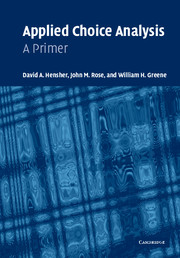Book contents
- Frontmatter
- Contents
- List of figures
- List of tables
- Preface
- Part I Basic topics
- 1 In the beginning
- 2 Basic notions of statistics
- 3 Choosing
- 4 Paradigms of choice data
- 5 Processes in setting up stated choice experiments
- 6 Choices in data collection
- 7 NLOGIT for applied choice analysis: a primer
- 8 Handling choice data
- 9 Case study: mode-choice data
- 10 Getting started modeling: the basic MNL model
- 11 Getting more from your model
- 12 Practical issues in the application of choice models
- Part II Advanced topics
- Glossary
- References
- Index
12 - Practical issues in the application of choice models
Published online by Cambridge University Press: 05 September 2012
- Frontmatter
- Contents
- List of figures
- List of tables
- Preface
- Part I Basic topics
- 1 In the beginning
- 2 Basic notions of statistics
- 3 Choosing
- 4 Paradigms of choice data
- 5 Processes in setting up stated choice experiments
- 6 Choices in data collection
- 7 NLOGIT for applied choice analysis: a primer
- 8 Handling choice data
- 9 Case study: mode-choice data
- 10 Getting started modeling: the basic MNL model
- 11 Getting more from your model
- 12 Practical issues in the application of choice models
- Part II Advanced topics
- Glossary
- References
- Index
Summary
The best way to predict the future is to invent it.
(Alan Kay)Introduction
The previous chapters have taken the reader, step by step, through all the essential tasks in problem definition, data specification, model preparation and estimation, and interpretation of the extensive number of outputs. Although we have introduced many application issues, it seems appropriate in the concluding chapter in part I to bring together what we regard as the range of issues that the analyst has to sort out when applying their empirically estimated choice models.
In giving some structure to applications, it is useful to recognize the main questions that will be asked by those wishing to apply the models (or wishing to have them applied by someone else). We make the distinction between applying the choice model today and in the future. Given the focus in this book on a cross-section approach (even if stated choice data are repeated observations on one individual – essentially an instantaneous “panel”) any applications into the future (what we call “establishing market potential,” but which is often referred to as “forecasting” or “prediction”) take the form of a “what-if” scenario application or a forecast of levels of all explanatory variables based on externally provided information on a single best estimated future.
In this chapter, the following four issues cover necessary activities in applying a choice model to a population of interest:
(1) Calibration of the model for base and forecast year(s)
(2) Designing a population data base for applications – synthetic observations
(3) Updating the attributes of alternatives
(4) Designing a decisions support system
- Type
- Chapter
- Information
- Applied Choice AnalysisA Primer, pp. 437 - 476Publisher: Cambridge University PressPrint publication year: 2005



